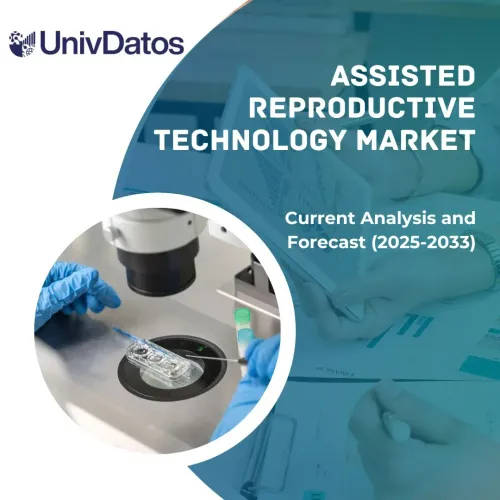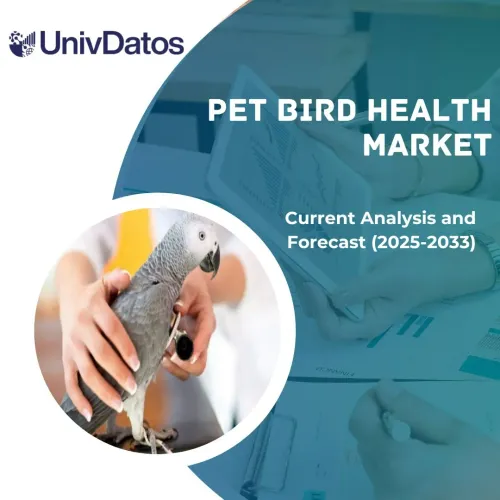- Home
- About Us
- Industry
- Services
- Reading
- Contact Us
Self-injection Devices Market: Current Analysis and Forecast (2022-2028)
Emphasis on Product (Autoinjectors, Pen injectors, Wearable injectors, and Needle-free injectors); Usability (Disposable and Reusable); Application (Cancer, Autoimmune disorders, Hormonal disorders, Pain management, and Others); and Region/Country
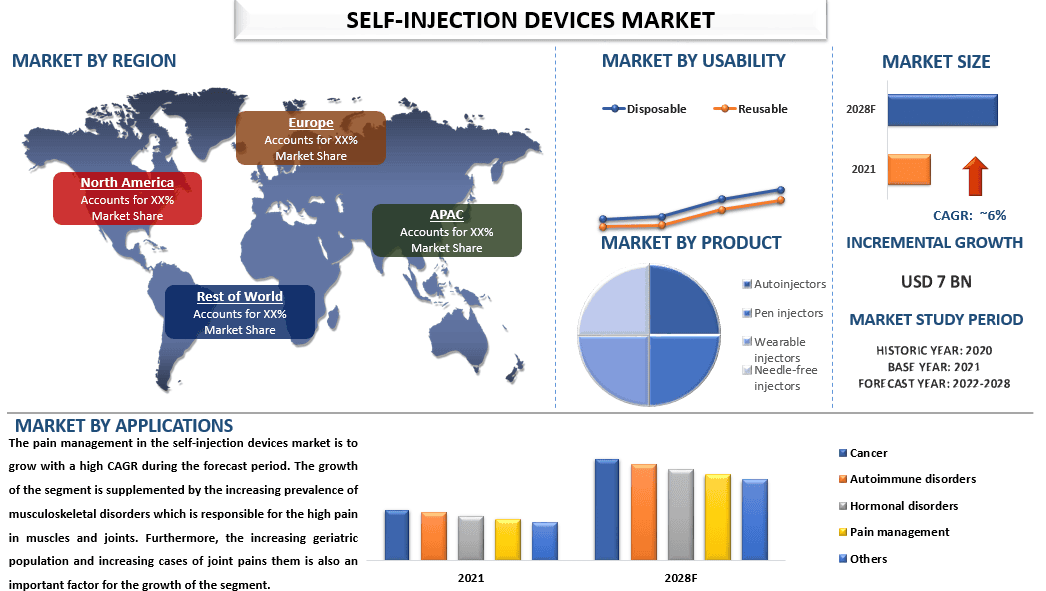
The Self- injection Devices market was valued at USD 7 billion in 2021 & is expected to grow at a CAGR of 6.0% from 2022-2028. Self-injection devices are medical devices designed for patients to self-administer medication through subcutaneous or intramuscular injection. These devices typically consist of a pre-filled syringe or auto-injector that is designed to be easy to use and minimizes the potential for needlestick injuries. The prevalence of chronic diseases is increasing, along with frequent product launches also attributes to the market growth of self-injection devices. For instance, in May 2022, medmix Drug Delivery (Haselmeier) launched its first fully featured autoinjector at Pharmapack in Paris.
Some of the major players operating in the market include Ypsomed AG; BD; Gerresheimer AG; Halozyme, Inc.; Haselmeier; NuGen Medical Devices; Owen Mumford Limited; SHL Medical AG; Pfizer Inc.; and Amgen Inc. Several M&As along with partnerships have been undertaken by these players to facilitate customers with hi-tech and innovative products/technologies.
Insights Presented in the Report
“Amongst product, the wearable injectors segment is expected to witness fast growth during the forecast period”
Based on product, the market is segmented into autoinjectors, pen injectors, wearable injectors, and needle-free injectors. Amongst these, the wearable injectors segment is expected to witness fastest growth during the forecast period. Wearable self-injection devices offer benefits such as improved medication adherence, help in reducing pain, and ease of administration are the important reasons for the fast growth of the segment.
“Amongst usability, the wearable injectors segment is expected to witness fast growth during the forecast period”
Based on product, the market is segmented into autoinjectors, pen injectors, wearable injectors, and needle-free injectors. Amongst these, the wearable injectors segment is expected to witness the fast growth during the forecast period. The benefits offered by wearable self-injection devices include improved medication adherence, reduced healthcare costs, and improved patient outcomes. Wearable self-injection devices can also help reduce pain, and being easy to administer is the major reason for the fast growth of the segment.
“Amongst applications, pain management held the majority share of the market in 2021”
Based on application, the market is segmented into cancer, autoimmune disorders, hormonal disorders, pain management, and others. Among these, pain management in the self-injection devices market is to grow with a high CAGR during the forecast period. The growth of the segment is supplemented by the increasing prevalence of musculoskeletal disorders which is responsible for the high pain in muscles and joints. Furthermore, the increasing geriatric population and increasing cases of joint pains them is also important factor for the growth of the segment.
“Asia Pacific is expected to grow with highest CAGR Self-injection Devices market during the forecast period”
Asia Pacific is expected to grow with the highest CAGR Self-injection Devices market during the forecast period. The region is home to a large patient population and the improving disposable incomes of people which is responsible for the increasing demand for self-injection devices are the important reasons for the market growth in the region. For instance, disposable personal income in India increased to USD 3321441.3 Million in 2022 from USD 2890595.4 Million in 2021.
Self-injection Devices Market Report Coverage
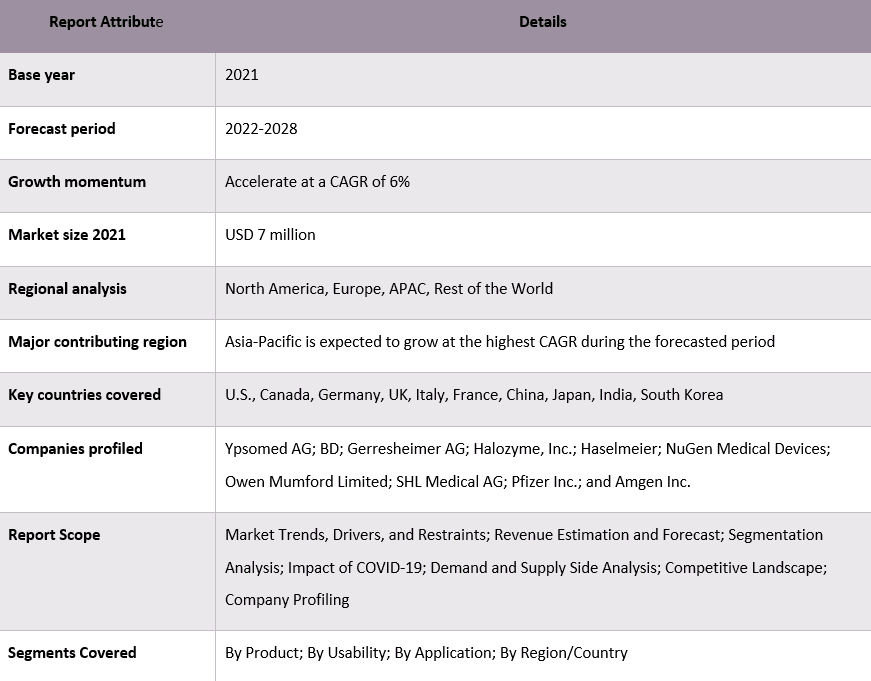
Reasons to buy this report:
- The study includes market sizing and forecasting analysis validated by authenticated key industry experts.
- The report presents a quick review of overall industry performance at one glance.
- The report covers an in-depth analysis of prominent industry peers with a primary focus on key business financials, product portfolios, expansion strategies, and recent developments.
- Detailed examination of drivers, restraints, key trends, and opportunities prevailing in the industry.
- The study comprehensively covers the market across different segments.
- Deep dive regional level analysis of the industry.
Customization Options:
The global self-injection devices market can further be customized as per the requirement or any other market segment. Besides this, UMI understands that you may have your own business needs, hence feel free to connect with us to get a report that completely suits your requirements.
Table of Content
Research Methodology for the Self-injection Devices Market Analysis (2022-2028)
Analyzing the historical market, estimating the current market, and forecasting the future market of the global self-injection devices market were the three major steps undertaken to create and analyze the adoption of self-injection devices in major regions globally. Exhaustive secondary research was conducted to collect the historical market numbers and estimate the current market size. Secondly, to validate these insights, numerous findings and assumptions were taken into consideration. Moreover, exhaustive primary interviews were also conducted, with industry experts across the value chain of the global self-injection devices market. Post assumption and validation of market numbers through primary interviews, we employed a top-down/bottom-up approach to forecasting the complete market size. Thereafter, market breakdown and data triangulation methods were adopted to estimate and analyze the market size of segments and sub-segments of the industry pertains to. Detailed methodology is explained below:
Analysis of Historical Market Size
Step 1: In-Depth Study of Secondary Sources:
Detail secondary study was conducted to obtain the historical market size of the self-injection devices market through company internal sources such as annual reports & financial statements, performance presentations, press releases, etc., and external sources including journals, news & articles, government publications, competitor publications, sector reports, third-party database, and other credible publications.
Step 2: Market Segmentation:
After obtaining the historical market size of the self-injection devices market, we conducted a detailed secondary analysis to gather historical market insights and share for different segments & sub-segments for major regions. Major segments are included in the report as product, usability, and application. Further country-level analyses were conducted to evaluate the overall adoption of testing models in that region.
Step 3: Factor Analysis:
After acquiring the historical market size of different segments and sub-segments, we conducted a detailed factor analysis to estimate the current market size of the self-injection devices market. Further, we conducted factor analysis using dependent and independent variables such as components and end-users of the self-injection devices market. A thorough analysis was conducted for demand and supply-side scenarios considering top partnerships, mergers and acquisitions, business expansion, and product launches in the Self-injection Devices market sector across the globe.
Current Market Size Estimate & Forecast
Current Market Sizing: Based on actionable insights from the above 3 steps, we arrived at the current market size, key players in the global self-injection devices market, and market shares of the segments. All the required percentage shares split, and market breakdowns were determined using the above-mentioned secondary approach and were verified through primary interviews.
Estimation & Forecasting: For market estimation and forecast, weights were assigned to different factors including drivers & trends, restraints, and opportunities available for the stakeholders. After analyzing these factors, relevant forecasting techniques i.e., the top-down/bottom-up approach were applied to arrive at the market forecast for 2028 for different segments and sub-segments across the major markets globally. The research methodology adopted to estimate the market size encompasses:
- The industry’s market size, in terms of revenue (USD) and the adoption rate of the Self-injection Devices market across the major markets domestically
- All percentage shares, splits, and breakdowns of market segments and sub-segments
- Key players in the global self-injection devices market in terms of products offered. Also, the growth strategies adopted by these players to compete in the fast-growing market
Market Size and Share Validation
Primary Research: In-depth interviews were conducted with the Key Opinion Leaders (KOLs) including Top Level Executives (CXO/VPs, Sales Head, Marketing Head, Operational Head, Regional Head, Country Head, etc.) across major regions. Primary research findings were then summarized, and statistical analysis was performed to prove the stated hypothesis. Inputs from primary research were consolidated with secondary findings, hence turning information into actionable insights.
Split of Primary Participants in Different Regions
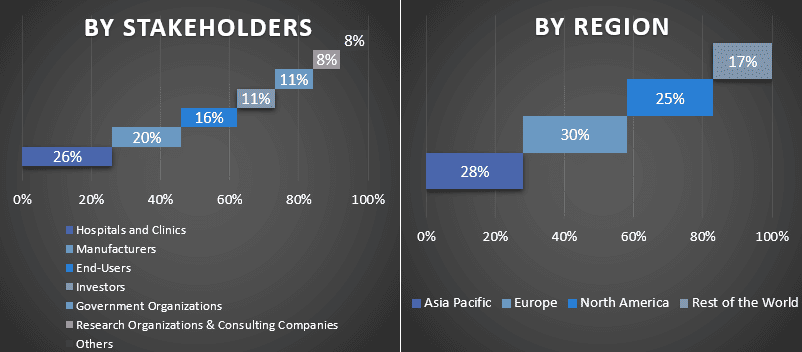
Market Engineering
The data triangulation technique was employed to complete the overall market estimation and to arrive at precise statistical numbers for each segment and sub-segment of the global Self-injection Devices market. data was split into several segments & sub-segments post studying various parameters and trends in the areas of the product, technology, and end-users in the global Self-injection Devices market.
The main objective of the Global Self-injection Devices Market Study
The current & future market trends of the global self-injection devices market were pinpointed in the study. Investors can gain strategic insights to base their discretion for investments on the qualitative and quantitative analysis performed in the study. Current and future market trends determined the overall attractiveness of the market at a regional level, providing a platform for the industrial participant to exploit the untapped market to benefit from a first-mover advantage. Other quantitative goals of the studies include:
- Analyze the current and forecast market size of the self-injection devices market in terms of value (USD). Also, analyze the current and forecast market size of different segments and sub-segments
- Segments in the study include areas of the product, usability, and application
- Define and analysis of the regulatory framework for the self-injection devices industry
- Analyze the value chain involved with the presence of various intermediaries, along with analyzing customer and competitor behaviors of the industry
- Analyze the current and forecast market size of the self-injection devices market for the major region
- Major countries of regions studied in the report include Asia Pacific, Europe, North America, and the Rest of the World
- Company profiles of the self-injection devices market and the growth strategies adopted by the market players to sustain in the fast-growing market
- Deep dive regional level analysis of the industry
Related Reports
Customers who bought this item also bought

